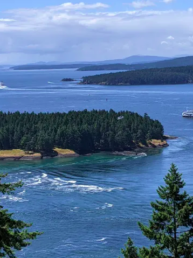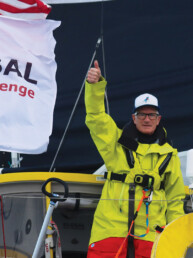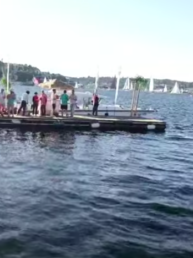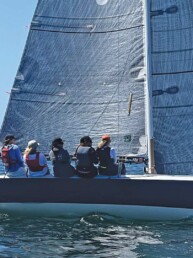Knocking Opportunities and a Post-Cruising Miracle
From the August 2020 issue of 48° North.
In 2012, my husband, Wayne, and I quit our jobs; abandoned friends, family, and mainstream modern conveniences in the Pacific Northwest; and ditched all our stuff for a nomadic life. Our plan: spend five years cruising, then sell our boat in Australia.
With nothing more than our airline luggage, we moved aboard our sturdy 1977 Pearson 365 Journey in St. Lucia and adjusted to our new living space. Comprising about 150-square feet, it was tiny, but came with a massive “backyard”—a phenomenal, ever-changing view, with no lawn to mow, and no rent or mortgage to pay.
We took the “Coconut Milk Run” back to Florida to get Journey ready to cross the Pacific. After getting broken-in by our boat that first year, we sailed the Bahamas the next season to restore our confidence in ourselves and our boat. In December 2014, we headed for the Panama Canal. We sailed 10,000 miles that year, including our 31-day passage from the Galapagos Islands to the French Marquesas. We re-routed to American Samoa in 2015, where we could replace boat parts and my laptop (along with Spike seasoning and SodaStream syrup) through US mail.
Opportunities in life always seem to knock along the way and we figured that when something did, we’d answer the call. The big knock we got during our cruising years came too early, in American Samoa. We learned that the communities there had a desperate need for school teachers. College-educated cruisers were in demand to teach a variety of subjects. They even provided housing. We were interested—Wayne could teach Chemistry and I would enjoy teaching English—but the case against doing it stacked up. Issues with boat storage and a problematic-to-boats-and-humans tuna processing factory combined with our desires to explore New Zealand’s Bay of Islands (which had recently been voted “best cruising grounds in the world” by Cruising World readers). We were not ready to stop cruising yet, so on we went.
In 2017, we rang in the new year aboard Journey under one of the most iconic fireworks shows in the world, a stone’s throw from the Sydney Opera House. That moment marked an accomplished goal for us: sailing halfway around the world and visiting 31 countries along the way. Our feelings of achievement combined with relief, satisfaction, exhilaration, and anxiety. Whatever challenges arose at sea—right down to the final frightening lightning storm as we approached Australia—we found a way to overcome. We were confident the same would be true in our next chapter.
Two weeks later, we sold Journey for the same price we paid, and about twice what we believed she would’ve sold for in the U.S. Suddenly, we faced a new dilemma—what do you do when you stop cruising?
Life After Cruising
Instead of coming home, we circumnavigated the rest of Oz on four wheels and no keels. First in a woefully underpowered van-camper conversion, then living out of a Land Cruiser. Four months later, we decided to return to the States. My parents weren’t getting any younger and I wanted to spend time with them while it was still an option. Other than that, we weren’t sure where we’d land or what we’d do once we arrived.
Upon our return, we experienced the same reaction as Robin Lee Graham, famed author of Dove and (at the time) the youngest person to circumnavigate the world—”culture shock.” Graham said, “At sea, I learned how little a person needs, not how much.”
I visited my parents in Florida, then flew to join Wayne in Portland, Oregon. We took refuge in my in-laws’ spare bedroom, grateful for a temporary landing place, while we sorted out our life. We mollified our new dirt-dweller existence with visions of dishwashers amidst full kitchens, cushy recliners, a queen-sized bed, endless hot showers, easy-streaming Wi-Fi—the life most of our friends, family, and colleagues take for granted.
Unfortunately, Portland’s giddy real estate market shook the assurance we had in our plan. The cost of living had doubled since we lived there in 2010. Month-to-month rental for a two-bedroom apartment in a neighborhood where graffiti and boarded windows were common started at $1,500. Throughout our cruising adventure, we averaged $1,800 per month for all our expenses. Feeling financially stunned helped us understand Portland’s burgeoning homeless populations sharing sidewalk space with residents of swanky half-million-dollar condos.
I posted about our conundrum on my blog. Then came a most unexpected message from friends . . .
Tom and Diane
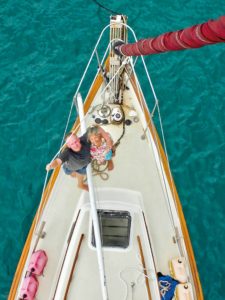 We’d met six years prior when I sought pre-cruising crew experience. A fellow I crewed for dropped anchor near the only other boat in the remote British Columbia anchorage. Most of the anchorage was 60-feet deep or more, leaving few spots shallow enough to anchor. After a heated discussion between the two captains over VHF radio about whether the boats were too close, we reached anchoring detente: both boats stayed put.
We’d met six years prior when I sought pre-cruising crew experience. A fellow I crewed for dropped anchor near the only other boat in the remote British Columbia anchorage. Most of the anchorage was 60-feet deep or more, leaving few spots shallow enough to anchor. After a heated discussion between the two captains over VHF radio about whether the boats were too close, we reached anchoring detente: both boats stayed put.
As is often the case, we were on a similar cruising track. Later on in Hartley Bay, the other cruisers, Tom* and Diane* on a Puget Trawler, came by to break bread; initiating our friendship. In the days that followed, we continued to cross paths and Tom even taught me how to tie a bowline. When I asked the couple how they’d met, their book-worthy answer spanned two days.
While my parents thought Wayne and I were crazy to sail the South Pacific, Tom and Diane served as surrogate parents, offering their hearty approval. In their younger days, they built a catamaran, and had their own grand sailing plans. Instead, as the years passed, they contented themselves with cruising British Columbia and the Northwest, motoring well into Alaska. Needless to say, they were a special pair.
Fast-forward back to 2017, to the culture-shocked re-entry into land life Wayne and I were attempting. And to my befuddled blog post wondering how returning nomads should find a place to live in Portland.
As much as Tom and Diane loved their trawler, mobility and maintenance issues prompted them to downsize from their 37-foot boat. They purchased an almost new trailerable 27-foot Ranger Tug, but continued to pay the monthly marina and insurance payments for their now unused trawler. They noticed similar boats didn’t seem to sell.
Tom saw my post and, with Diane’s blessing, made an incredible offer: “Would you like our trawler as a live-aboard?” Tom asked. “We can sign the title over to you if you’re interested.”
Serendipity
Once again, opportunity was knocking. The sheer generosity of their offer flabbergasted Wayne and me. Nonetheless, we were keenly interested. Temporarily crashing at my in-laws aside, we were not accustomed to a helping hand in tough financial transitions. Humbled and grateful, we began to explore the option.
We checked out Portland marinas where liveaboards were allowed and were pleasantly surprised to discover there was ample availability. Covered slips with extra liveaboard fees ran a little over $600; far less than an unfurnished apartment, and in a neighborhood that appealed more to us. As a bonus—unlike apartments—liveaboard boats do not need furniture; it’s already all built in.
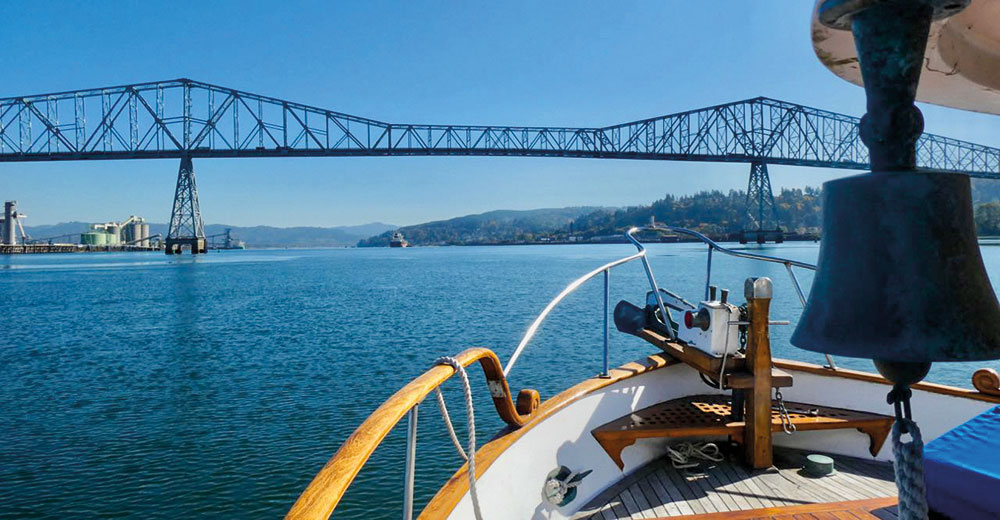 When we lived aboard our sailboat in Florida, Wayne worked a swing-shift. Every time I stepped aboard or cooked, I woke Wayne up. An understatement—when it came to domestic bliss, that was not our finest point. Wayne would again work odd hours and we still needed to make sure the trawler would work for us as a liveaboard.
When we lived aboard our sailboat in Florida, Wayne worked a swing-shift. Every time I stepped aboard or cooked, I woke Wayne up. An understatement—when it came to domestic bliss, that was not our finest point. Wayne would again work odd hours and we still needed to make sure the trawler would work for us as a liveaboard.
With easily twice the interior living space, a rear stateroom in addition to the V-berth, and an extra head, the trawler offered far better liveaboard accommodation than our cruising sailboat. Unlike Journey, where all the cabin living areas shared the same level, the trawler’s staterooms and bathrooms were a half-level lower than the galley-settee area, which was better for our divergent schedules.
After two nights aboard, we took Tom and Diane up on their incredibly generous offer. Tom spent hours walking us through the boat’s details and followed up with many emails.
”Our new boat ‘owns’ this boat’s name. You will have to re-name the boat,” Tom insisted, when we met to sign the title transfer. We were more than happy to oblige.
While we figured, eventually, we’d find ourselves on a boat again, never in our wildest dreams did we expect it to happen so soon or in the way it did. Given how the trawler came to us, we dubbed her M/V Serendipity.
Home
 Other than eight months saying my last goodbyes to my parents in Florida, wherever Serendipity is, we now call home. During the summers, we anchor off our favorite haunts on the Columbia River, walking barefoot on the beach while eagles circle overhead. We’ve taken Serendipity cruising in the San Juan Islands and British Columbia. We spend the winters tucked into covered moorage in the Portland area.
Other than eight months saying my last goodbyes to my parents in Florida, wherever Serendipity is, we now call home. During the summers, we anchor off our favorite haunts on the Columbia River, walking barefoot on the beach while eagles circle overhead. We’ve taken Serendipity cruising in the San Juan Islands and British Columbia. We spend the winters tucked into covered moorage in the Portland area.
Last fall, we enjoyed the best highlight of all: we joined Tom and Diane on their cruise in British Columbia. It must have felt strange for them to be served dinner on the boat they called their own for ten years. We did our best to make them proud of their decision. Serendipity shines with their love, and ours. We continue to feel humbled and grateful every day.
Reflecting on our cruising experience abroad and the journey that brought us together with Serendipity, we are amazed at the way our connections with people—other cruisers, locals in the many countries we visited, and Tom and Diane—have strengthened our faith in humanity, opened doors of possibility, and somehow made us feel more at home with ourselves, wherever we are.
While all our futures are especially uncertain these days, we’re tentatively planning a grand adventure with Serendipity for this fall. We still check in frequently with Tom and Diane. They assure us, “The right thing will fall into place for you.” We believe they are right. We remain open, ready to once again respond when opportunity knocks.
*Not their actual names. They prefer to keep their identity private.
Dana Greyson
Dana Greyson and her husband, Wayne, live aboard M/V Serendipity in the Portland, Oregon area. When she’s not freelance writing, editing or working on her sailing travel memoir (due out 2021—to learn more, check out her website at
www.DanaGreyson.com), you’ll find her hiking, kayaking, or making the best damned berry cobbler you’ll ever eat.

